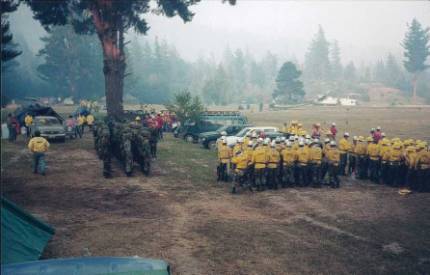Chile: Forest Fires – An Evil that Chile Controls (IFFN No. 8 – January 1993)
Forest Fires:
An Evil that Chile Controls
(IFFN No. 8 – January 1993, p. 5-7)
The surface area affected by forest fires in Chile diminished by 62 per cent in the season that ended in May this year. The result is a distinct reflection on the efficiency in combating these disasters.
Effectiveness: This concept can serve to summarise the work of the Fire Control Department of the National Forestry Corporation (CONAF) during the last forest-fire fighting season. The greatest achievement was having managed to reduce the surface area affected over the season, which runs from November to May, by 62 per cent, from the five-year period average of 63,530 hectares to only 24,153 hectares.
For the head of the Fire Control Department, Miguel Angel Ahumada, the outstanding thing about this success was that “the affected area was reduced despite the level of occurrence of forest fires having remained unchanged. The five-year period average was 4,835 fires and last season there were 4,786. This is clear proof of efficiency in combating forest fires”. Another point that Miguel Angel Ahumada stressed was that the reduction of the surface area affected by forest fires in the country meant that there had been a drop in the average hectares per fire. The average, which had been 13.14 hectares per fire, dropped to 7.47 hectares per fire for the season that ended last May. For all the members of CONAF’s Fire Control Department, this figure is truly a historic landmark.
“When taking stock”, Ahumada said, “one cannot ignore that the improved work of the fire-fighters, who are the ones that achieve these results, was favoured by the quality of the clothing having been maintained and the improvement in some equipment , such as for example boots as well as camp installations. In the safety aspect, the use of a double-filter mask should be highlighted”. As regards the equipment the fire-fighters work with, he indicated that the most important feature of the season was the contracting and operating of the Bell 205 A-1 Helitanker helicopter, which was a valuable contribution in Region VIII. In addition, a communications network was implemented that made it possible in coordination with the other seven existing helicopters in other regions, to be prepared to face any high-risk emergency, as concerns forest fires, that should arise in this country.
Prevention: One aspect that was reinforced last season, with positive results, was prevention. “Based on the fact that one hundred per cent of the forest fires are caused by man, it was essential that greater efforts should be thrown into working on the occurrence of fires. The end objective is to achieve an ostensible reduction in fire-occurrence levels”, Ahumada explained. And a clear proof that this statement was put into practice was that CONAF, exerting a great effort, substantially increased its prevention budget.

Fig.1. Prevention and efficiency in combating forest fires were the essential elements of the success achieved in the recent season, during which the affected surface area was reduced. Outstanding in the prevention were the motorcyclists. (source: Chilean Forestry News)
One variable that the head of CONAF’s Fire Control Department did not obviate, in the good results achieved last season, was the coordination with the forestry companies which, through their own Prevention Programmes, have high-level brigades and equipment for fighting forest fires. Miguel Angel Ahumada ended by saying that “the existing understanding enabled an optimum use of each available resource. We hope to keep on this path of teamwork, particularly as concerns prevention, a topic we feel the same way about”.
Tab.1. Summary of wildfire occurrence and area affected by fire in Chile during the period 1986-1991.
Source: Fire Control Programme Statistical System, CONAF

From: Chilean Forestry News (August 1992)



















